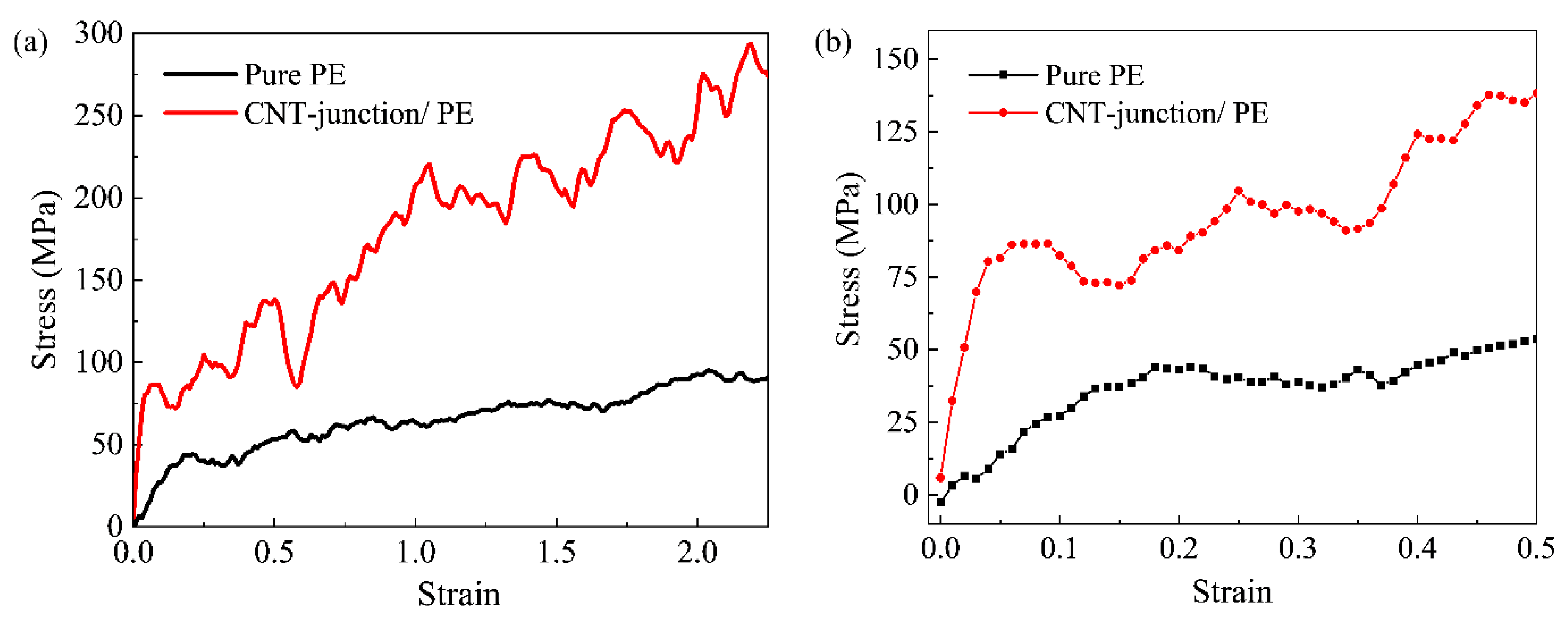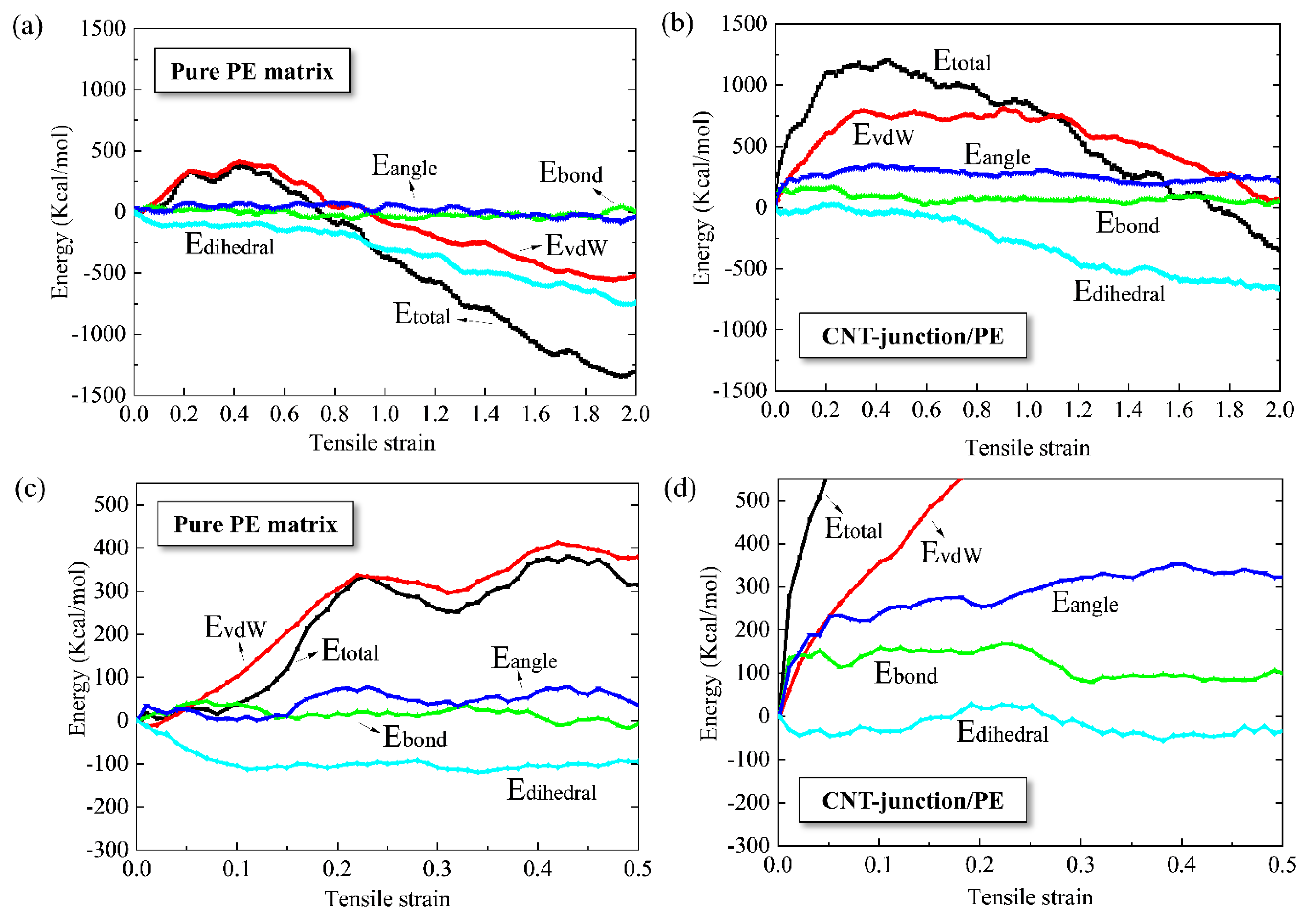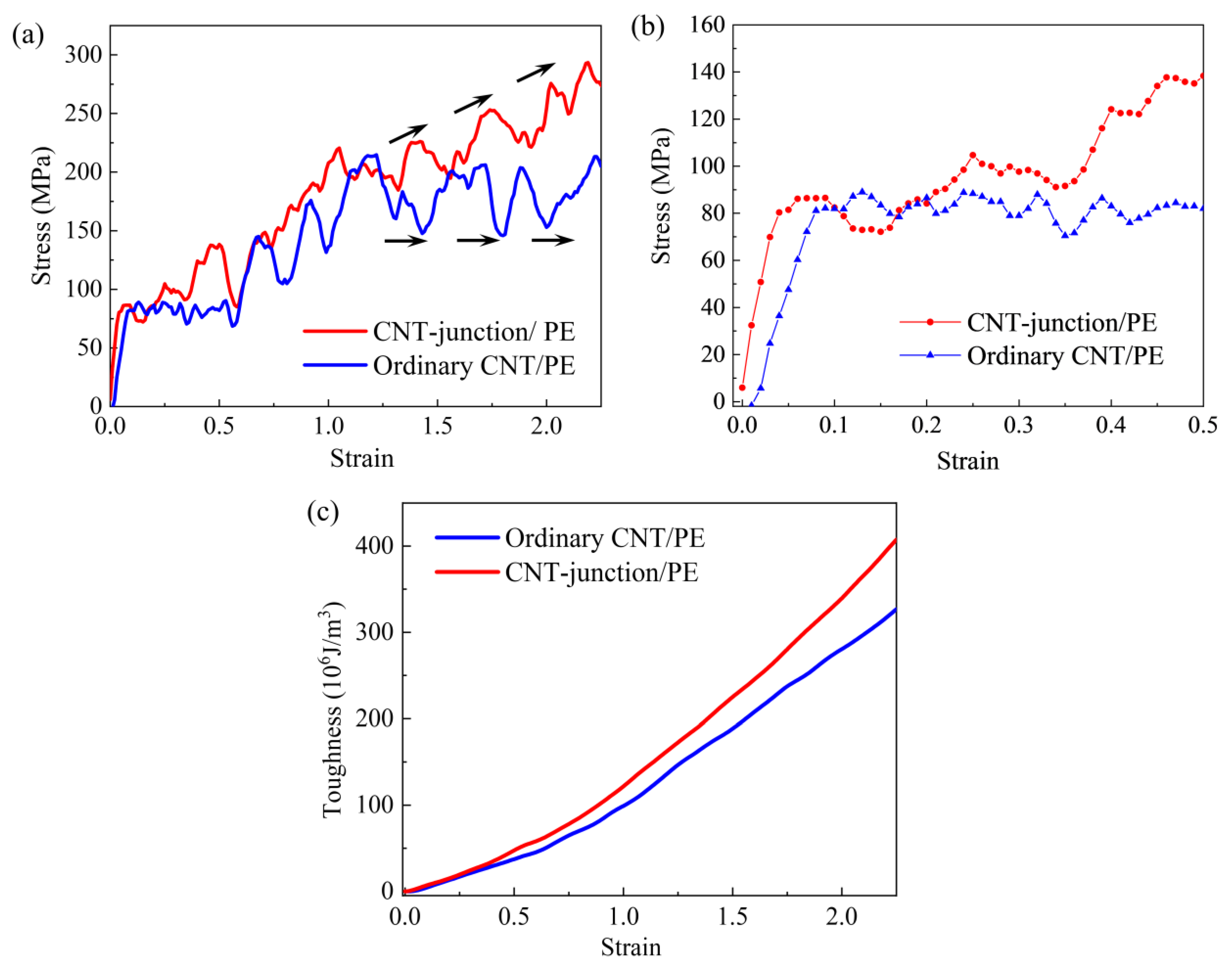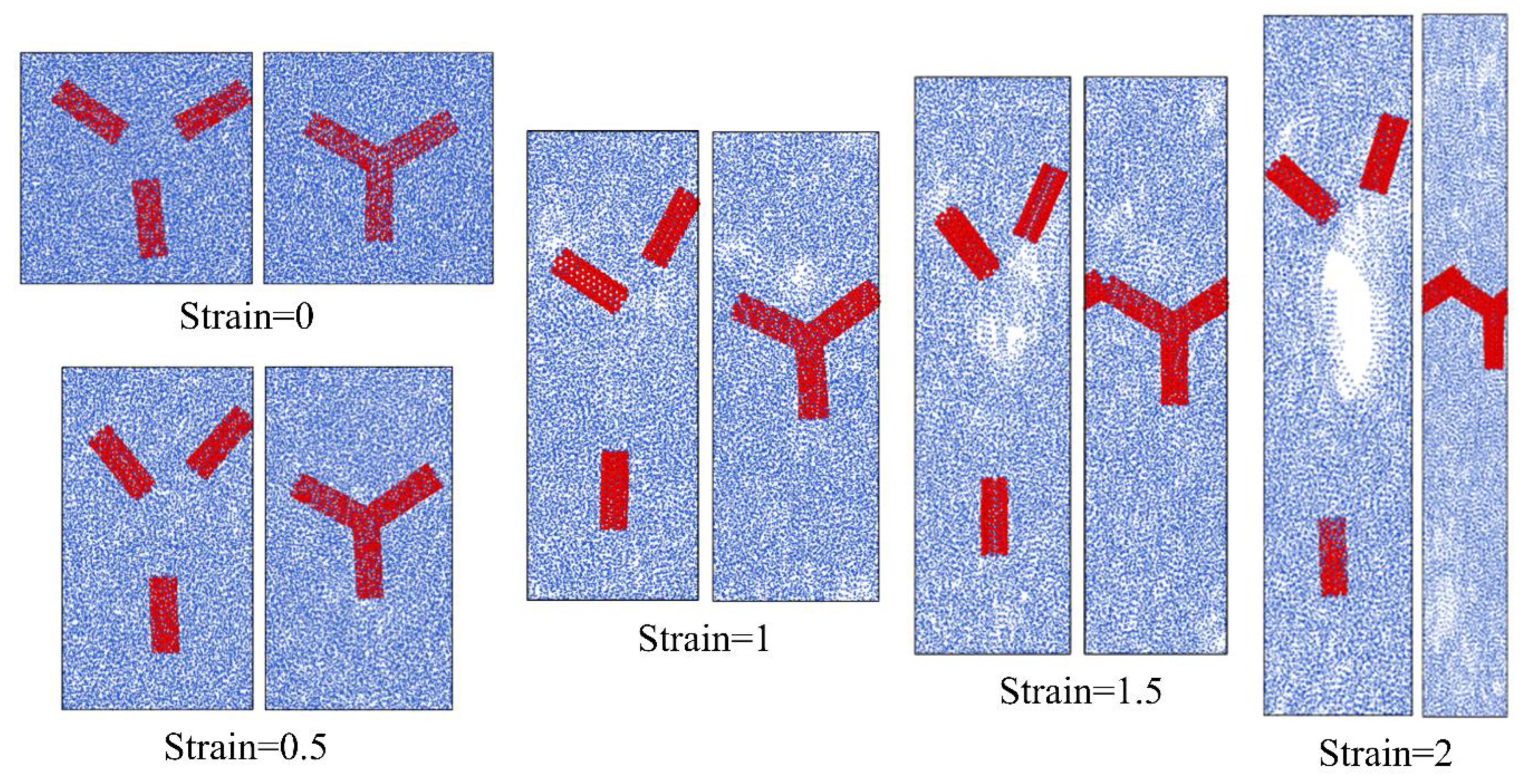Role of the Carbon Nanotube Junction in the Mechanical Performance of Carbon Nanotube/Polyethylene Nanocomposites: A Molecular Dynamics Study
Abstract
:1. Introduction
2. Materials and Methods
- (1)
- Initial structure optimization at low temperature: The system was put into a canonical ensemble (NVT) for 100 ps at the temperature of 0.5 K. At this stage, the position of the CNTs was fixed. This enabled the polymer segments to have an initial position adjustment and optimization. A low temperature limits the corresponding interaction forces, which enables the entire system to have step-by-step adjustment without oversized movements of atoms.
- (2)
- Annealing process with the temperature rising to 800 K: Under an isothermal−isobaric ensemble (NPT), a gradually increasing temperature from 0.5 K to 800 K was applied to the system within 250 ps. After reaching 800 K, the system kept running for 100 ps at a constant temperature of 800 K. For the final step, the system was cooled down from 800 K to the required temperature for a period of 250 ps. In this process, the simulation box was adjusted to the corresponding sizes under the control of pressure, and the morphology of the polymer chains was optimized to a lower energy state with the assistance of the large thermal vibrations at a high temperature.
- (3)
- Final equilibrium process with fixed temperature: With the unchanged ensemble, the system came to an equilibrium state at the required temperature for a long period of 1 ns. At this stage, the constraints of CNTs were removed. The polymer chains kept adjusting their morphology with additional interactions of CNTs. All residual stresses in the entire system were released.
3. Results and Discussions
3.1. Reinforcement Efficiency of the CNT Junction Compared to Pure PE
3.2. Comparisons of the Tensile Performance between the CNT-Junction/PE Nanocomposite and the Ordinary CNT/PE Nanocomposite
4. Conclusions
Author Contributions
Funding
Data Availability Statement
Conflicts of Interest
References
- Soni, S.K.; Thomas, B.; Thomas, S.B.; Tile, P.S.; Sakharwade, S.G. Carbon Nanotubes as Exceptional Nanofillers in Polymer and Polymer/Fiber Nanocomposites: An Extensive Review. Mater. Today Commun. 2023, 37, 107358. [Google Scholar] [CrossRef]
- Ruoff, R.S.; Lorents, D.C. Mechanical and Thermal Properties of Carbon Nanotubes. Carbon 1995, 33, 925–930. [Google Scholar] [CrossRef]
- Charlier, J.-C.; Blase, X.; Roche, S. Electronic and Transport Properties of Nanotubes. Rev. Mod. Phys. 2007, 79, 677–732. [Google Scholar] [CrossRef]
- Gong, M.; Zhang, L.; Wan, P. Polymer Nanocomposite Meshes for Flexible Electronic Devices. Prog. Polym. Sci. 2020, 107, 101279. [Google Scholar] [CrossRef]
- Abubakre, O.K.; Medupin, R.O.; Akintunde, I.B.; Jimoh, O.T.; Abdulkareem, A.S.; Muriana, R.A.; James, J.A.; Ukoba, K.O.; Jen, T.-C.; Yoro, K.O. Carbon Nanotube-Reinforced Polymer Nanocomposites for Sustainable Biomedical Applications: A Review. J. Sci. Adv. Mater. Devices 2023, 8, 100557. [Google Scholar] [CrossRef]
- Liu, S.; Qin, S.; Jiang, Y.; Song, P.; Wang, H. Lightweight High-Performance Carbon-Polymer Nanocomposites for Electromagnetic Interference Shielding. Compos. Part A Appl. Sci. Manuf. 2021, 145, 106376. [Google Scholar] [CrossRef]
- Alian, A.R.; Kundalwal, S.I.; Meguid, S.A. Interfacial and Mechanical Properties of Epoxy Nanocomposites Using Different Multiscale Modeling Schemes. Compos. Struct. 2015, 131, 545–555. [Google Scholar] [CrossRef]
- Liu, X.; Yang, Q.-S.; He, X.-Q.; Liew, K.-M. Self-Densified Microstructure and Enhanced Properties of Carbon Nanotube Fiber by Infiltrating Polymer. Carbon 2016, 106, 188–194. [Google Scholar] [CrossRef]
- Kumar, S. Investigating Effect of CNT Agglomeration in CNT/Polymer Nanocomposites Using Multiscale Finite Element Method. Mech. Mater. 2023, 183, 104706. [Google Scholar] [CrossRef]
- Güryel, S.; Walker, M.; Geerlings, P.; De Proft, F.; Wilson, M.R. Molecular Dynamics Simulations of the Structure and the Morphology of Graphene/Polymer Nanocomposites. Phys. Chem. Chem. Phys. 2017, 19, 12959–12969. [Google Scholar] [CrossRef]
- Skountzos, E.N.; Anastassiou, A.; Mavrantzas, V.G.; Theodorou, D.N. Determination of the Mechanical Properties of a Poly(Methyl Methacrylate) Nanocomposite with Functionalized Graphene Sheets through Detailed Atomistic Simulations. Macromolecules 2014, 47, 8072–8088. [Google Scholar] [CrossRef]
- Zhao, Y.; Byshkin, M.; Cong, Y.; Kawakatsu, T.; Guadagno, L.; De Nicola, A.; Yu, N.; Milano, G.; Dong, B. Self-Assembly of Carbon Nanotubes in Polymer Melts: Simulation of Structural and Electrical Behaviour by Hybrid Particle-Field Molecular Dynamics. Nanoscale 2016, 8, 15538–15552. [Google Scholar] [CrossRef] [PubMed]
- Singh, A.; Kumar, D. Effect of Temperature on Elastic Properties of CNT-Polyethylene Nanocomposite and Its Interface Using MD Simulations. J. Mol. Model. 2018, 24, 178. [Google Scholar] [CrossRef] [PubMed]
- Liu, L.-Y.; Zhang, Z.-X.; Gou, X.-F.; Yang, H.-X. Molecular Modelling of the Effect of Loading Rate on Elastic Properties of CNT-Polyethylene Nanocomposite and Its Interface. Mater. Res. Express 2019, 6, 1250d2. [Google Scholar] [CrossRef]
- Yazdanparast, R.; Rafiee, R. Investigating the Influence of Pull-out Speed on the Interfacial Properties and the Pull-out Behavior of CNT/Polymer Nanocomposites. Compos. Struct. 2023, 316, 117049. [Google Scholar] [CrossRef]
- Wei, C. Radius and Chirality Dependent Conformation of Polymer Molecule at Nanotube Interface. Nano Lett. 2006, 6, 1627–1631. [Google Scholar] [CrossRef]
- Jian, W.; Lau, D. Understanding the Effect of Functionalization in CNT-Epoxy Nanocomposite from Molecular Level. Compos. Sci. Technol. 2020, 191, 108076. [Google Scholar] [CrossRef]
- Li, Y.; Liu, Y.; Peng, X.; Yan, C.; Liu, S.; Hu, N. Pull-out Simulations on Interfacial Properties of Carbon Nanotube-Reinforced Polymer Nanocomposites. Comput. Mater. Sci. 2011, 50, 1854–1860. [Google Scholar] [CrossRef]
- Li, Y.; Wang, S.; Wang, Q.; Xing, M. A Comparison Study on Mechanical Properties of Polymer Composites Reinforced by Carbon Nanotubes and Graphene Sheet. Compos. Part B Eng. 2018, 133, 35–41. [Google Scholar] [CrossRef]
- Abhiram, B.R.; Ghosh, D. Influence of Nanofiller Agglomeration on Fracture Properties of Polymer Nanocomposite: Insights from Atomistic Simulation. Eng. Fract. Mech. 2023, 290, 109503. [Google Scholar] [CrossRef]
- Alian, A.R.; Meguid, S.A. Molecular Dynamics Simulations of the Effect of Waviness and Agglomeration of CNTs on Interface Strength of Thermoset Nanocomposites. Phys. Chem. Chem. Phys. 2017, 19, 4426–4434. [Google Scholar] [CrossRef] [PubMed]
- Wu, Y.; Wang, Z.; Liu, X.; Shen, X.; Zheng, Q.; Xue, Q.; Kim, J.-K. Ultralight Graphene Foam/Conductive Polymer Composites for Exceptional Electromagnetic Interference Shielding. ACS Appl. Mater. Interfaces 2017, 9, 9059–9069. [Google Scholar] [CrossRef] [PubMed]
- Ma, Q.; Hao, B.; Yue, X.; Ma, P.-C. Matrix Dominated Positive/Negative Piezoresistance in Conducting Polymer Nanocomposites Reinforced by CNT Foam. Polymer 2022, 257, 125288. [Google Scholar] [CrossRef]
- Zhao, J.; Zhang, W.; Lu, Q.; Liao, T.; Li, W.; Zhang, X.; Li, Q. High Energy-Capacity and Multiresponsive Phase Change Fibers via in Situ Polymer Composition with Expanded Carbon Nanotube Networks. Chem. Eng. J. 2024, 481, 148262. [Google Scholar] [CrossRef]
- Duan, K.; Li, Y.; Li, L.; Hu, Y.; Wang, X. Pillared Graphene as Excellent Reinforcement for Polymer-Based Nanocomposites. Mater. Des. 2018, 147, 11–18. [Google Scholar] [CrossRef]
- Zhou, Z.; Zhang, H.; Qiu, J.; Chen, P.; Sun, W. Atomic Insights into Synergistic Effect of Pillared Graphene by Carbon Nanotube on the Mechanical Properties of Polymer Nanocomposites. Nano Mater. Sci. 2022, 4, 235–243. [Google Scholar] [CrossRef]
- Zhang, X.; Li, W.; Yang, M.; Zhao, Z.; He, Y.; Zheng, S.; Ma, J.; Chen, L. Temperature-Dependent Tensile Strength of CNT/Polymer Nanocomposites Considering the Effects of CNT Networks and Waviness: Characterization and Modeling. Polymer 2022, 263, 125526. [Google Scholar] [CrossRef]
- Thompson, S.M.; Talò, M.; Krause, B.; Janke, A.; Lanzerotti, M.; Capps, J.; Lanzara, G.; Lacarbonara, W. The Effect of Branched Carbon Nanotubes as Reinforcing Nano-Filler in Polymer Nanocomposites. Compos. Struct. 2022, 295, 115794. [Google Scholar] [CrossRef]
- Li, Y.; Kröger, M.; Liu, W.K. Nanoparticle Geometrical Effect on Structure, Dynamics and Anisotropic Viscosity of Polyethylene Nanocomposites. Macromolecules 2012, 45, 2099–2112. [Google Scholar] [CrossRef]
- Zhang, B.; Li, J.; Gao, S.; Liu, W.; Liu, Z. Comparison of Thermomechanical Properties for Weaved Polyethylene and Its Nanocomposite Based on the CNT Junction by Molecular Dynamics Simulation. J. Phys. Chem. C 2019, 123, 19412–19420. [Google Scholar] [CrossRef]
- Wei, D.; Liu, Y. The Intramolecular Junctions of Carbon Nanotubes. Adv. Mater. 2008, 20, 2815–2841. [Google Scholar] [CrossRef]
- Xue, B.; Shao, X.; Cai, W. Structures and Stabilities of Multi-Terminal Carbon Nanotube Junctions. Comput. Mater. Sci. 2008, 43, 531–539. [Google Scholar] [CrossRef]
- Guru, K.; Mishra, S.B.; Shukla, K.K. Effect of Temperature and Functionalization on the Interfacial Properties of CNT Reinforced Nanocomposites. Appl. Surf. Sci. 2015, 349, 59–65. [Google Scholar] [CrossRef]
- Hu, Y.; Ding, J.L. Effects of Morphologies of Carbon Nanofillers on the Interfacial and Deformation Behavior of Polymer Nanocomposites—A Molecular Dynamics Study. Carbon 2016, 107, 510–524. [Google Scholar] [CrossRef]
- Peng, X.; Meguid, S.A. Molecular Simulations of the Influence of Defects and Functionalization on the Shear Strength of Carbon Nanotube-Epoxy Polymer Interfaces. Comput. Mater. Sci. 2017, 126, 204–216. [Google Scholar] [CrossRef]
- Nosé, S. A Molecular Dynamics Method for Simulations in the Canonical Ensemble. Mol. Phys. 1984, 52, 255–268. [Google Scholar] [CrossRef]
- Sun, H.; Mumby, S.J.; Maple, J.R.; Hagler, A.T. An Ab Initio CFF93 All-Atom Force Field for Polycarbonates. J. Am. Chem. Soc. 1994, 116, 2978–2987. [Google Scholar] [CrossRef]
- Yuan, Z.; Lu, Z.; Chen, M.; Yang, Z.; Xie, F. Interfacial Properties of Carboxylic Acid Functionalized CNT/Polyethylene Composites: A Molecular Dynamics Simulation Study. Appl. Surf. Sci. 2015, 351, 1043–1052. [Google Scholar] [CrossRef]
- Thompson, A.P.; Aktulga, H.M.; Berger, R.; Bolintineanu, D.S.; Brown, W.M.; Crozier, P.S.; In’t Veld, P.J.; Kohlmeyer, A.; Moore, S.G.; Nguyen, T.D.; et al. LAMMPS—A Flexible Simulation Tool for Particle-Based Materials Modeling at the Atomic, Meso, and Continuum Scales. Comput. Phys. Commun. 2022, 271, 108171. [Google Scholar] [CrossRef]
- Griebel, M.; Hamaekers, J. Molecular Dynamics Simulations of the Elastic Moduli of Polymer–Carbon Nanotube Composites. Comput. Methods Appl. Mech. Eng. 2004, 193, 1773–1788. [Google Scholar] [CrossRef]
- Hossain, D.; Tschopp, M.A.; Ward, D.K.; Bouvard, J.L.; Wang, P.; Horstemeyer, M.F. Molecular Dynamics Simulations of Deformation Mechanisms of Amorphous Polyethylene. Polymer 2010, 51, 6071–6083. [Google Scholar] [CrossRef]
- Gersappe, D. Molecular Mechanisms of Failure in Polymer Nanocomposites. Phys. Rev. Lett. 2002, 89, 58301. [Google Scholar] [CrossRef] [PubMed]
- Rahmat, M.; Hubert, P. Carbon Nanotube–Polymer Interactions in Nanocomposites: A Review. Compos. Sci. Technol. 2011, 72, 72–84. [Google Scholar] [CrossRef]
- Zhang, L.W.; Ji, W.M.; Liew, K.M. Mechanical Properties of Diamond Nanothread Reinforced Polymer Composites. Carbon 2018, 132, 232–240. [Google Scholar] [CrossRef]
- Liu, J.; Shen, J.; Zheng, Z.; Wu, Y.; Zhang, L. Revealing the Toughening Mechanism of Graphene–Polymer Nanocomposite through Molecular Dynamics Simulation. Nanotechnology 2015, 26, 291003. [Google Scholar] [CrossRef]
- Li, M.; Zhou, H.; Zhang, Y.; Liao, Y.; Zhou, H. The Effect of Defects on the Interfacial Mechanical Properties of Graphene/Epoxy Composites. RSC Adv. 2017, 7, 46101–46108. [Google Scholar] [CrossRef]
- Yang, S.; Yu, S.; Cho, M. Influence of Thrower–Stone–Wales Defects on the Interfacial Properties of Carbon Nanotube/Polypropylene Composites by a Molecular Dynamics Approach. Carbon 2013, 55, 133–143. [Google Scholar] [CrossRef]








| Models | CNT Atoms | Matrix Atoms | Total Atoms | Final Density at 300 K (g/cm3) |
|---|---|---|---|---|
| CNT-junction/PE | C 798 H 36 | C 10,000 H 20,100 | 30,934 | 0.854 |
| Ordinary CNT/PE | C 792 H 72 | C 10,000 H 20,100 | 30,964 | 0.850 |
| Pure PE | 0 | C 12,800 H 25,728 | 38,528 | 0.80 |
Disclaimer/Publisher’s Note: The statements, opinions and data contained in all publications are solely those of the individual author(s) and contributor(s) and not of MDPI and/or the editor(s). MDPI and/or the editor(s) disclaim responsibility for any injury to people or property resulting from any ideas, methods, instructions or products referred to in the content. |
© 2024 by the authors. Licensee MDPI, Basel, Switzerland. This article is an open access article distributed under the terms and conditions of the Creative Commons Attribution (CC BY) license (https://creativecommons.org/licenses/by/4.0/).
Share and Cite
Shi, X.; He, X.; Liu, X. Role of the Carbon Nanotube Junction in the Mechanical Performance of Carbon Nanotube/Polyethylene Nanocomposites: A Molecular Dynamics Study. Nanomaterials 2024, 14, 520. https://doi.org/10.3390/nano14060520
Shi X, He X, Liu X. Role of the Carbon Nanotube Junction in the Mechanical Performance of Carbon Nanotube/Polyethylene Nanocomposites: A Molecular Dynamics Study. Nanomaterials. 2024; 14(6):520. https://doi.org/10.3390/nano14060520
Chicago/Turabian StyleShi, Xian, Xiaoqiao He, and Xuefeng Liu. 2024. "Role of the Carbon Nanotube Junction in the Mechanical Performance of Carbon Nanotube/Polyethylene Nanocomposites: A Molecular Dynamics Study" Nanomaterials 14, no. 6: 520. https://doi.org/10.3390/nano14060520







